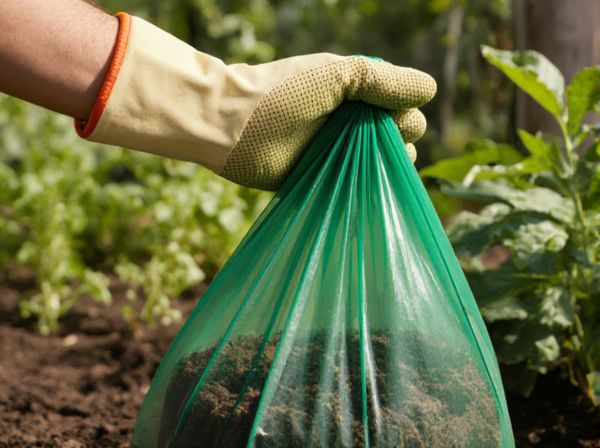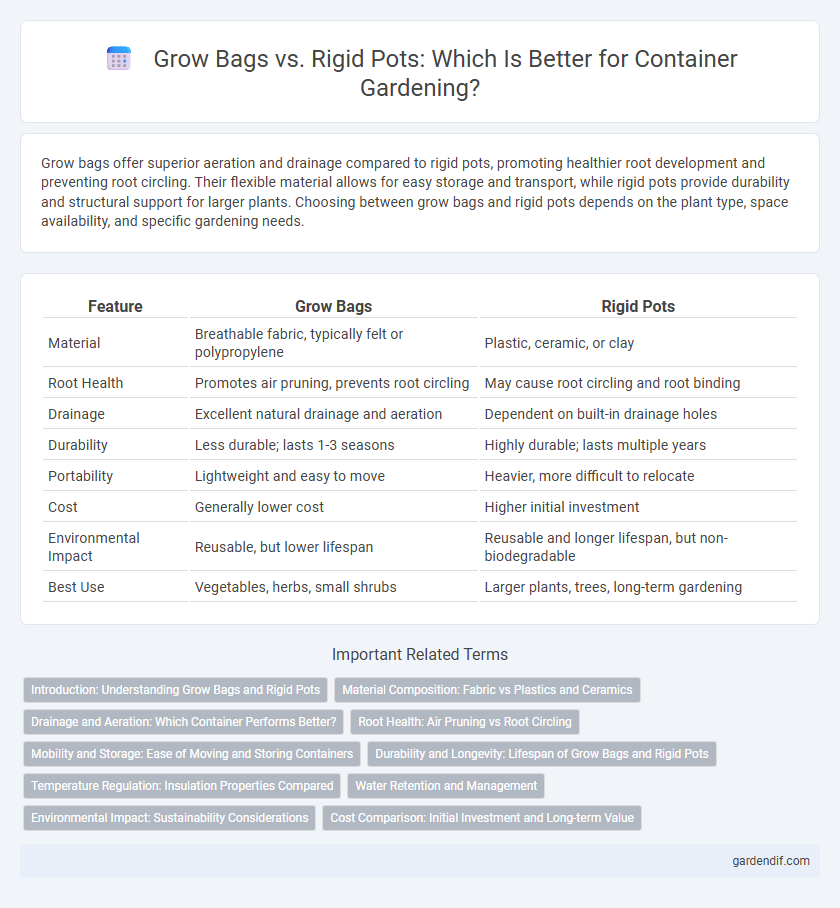
Grow bags vs rigid pots Illustration
Grow bags offer superior aeration and drainage compared to rigid pots, promoting healthier root development and preventing root circling. Their flexible material allows for easy storage and transport, while rigid pots provide durability and structural support for larger plants. Choosing between grow bags and rigid pots depends on the plant type, space availability, and specific gardening needs.
Table of Comparison
| Feature | Grow Bags | Rigid Pots |
|---|---|---|
| Material | Breathable fabric, typically felt or polypropylene | Plastic, ceramic, or clay |
| Root Health | Promotes air pruning, prevents root circling | May cause root circling and root binding |
| Drainage | Excellent natural drainage and aeration | Dependent on built-in drainage holes |
| Durability | Less durable; lasts 1-3 seasons | Highly durable; lasts multiple years |
| Portability | Lightweight and easy to move | Heavier, more difficult to relocate |
| Cost | Generally lower cost | Higher initial investment |
| Environmental Impact | Reusable, but lower lifespan | Reusable and longer lifespan, but non-biodegradable |
| Best Use | Vegetables, herbs, small shrubs | Larger plants, trees, long-term gardening |
Introduction: Understanding Grow Bags and Rigid Pots
Grow bags and rigid pots are popular container options for gardening, each offering unique benefits for plant growth. Grow bags, made from breathable fabric, promote air pruning of roots and improve soil aeration, preventing root circling and encouraging healthy root systems. Rigid pots, typically constructed from plastic or ceramic, provide structural stability and retain moisture longer, making them ideal for plants requiring consistent hydration.
Material Composition: Fabric vs Plastics and Ceramics
Grow bags are crafted from breathable fabric materials like polypropylene or felt, which promote air pruning and improved root aeration, enhancing plant health. In contrast, rigid pots are typically made from plastics such as polyethylene or ceramics, offering durability but limited airflow to roots. The porous nature of fabric grow bags reduces waterlogging, while plastic and ceramic pots retain moisture longer but may cause root circling.
Drainage and Aeration: Which Container Performs Better?
Grow bags excel in drainage and aeration due to their breathable fabric that allows excess water to escape and promotes oxygen flow to roots, reducing risks of overwatering and root rot. Rigid pots often have limited drainage holes, which can lead to waterlogging and less root oxygenation, negatively impacting plant health. Optimal root development is more achievable in grow bags, especially for plants requiring well-aerated soil conditions.
Root Health: Air Pruning vs Root Circling
Grow bags enhance root health through air pruning, which naturally trims roots when they reach the fabric edge, preventing root circling and promoting a dense, fibrous root system. Rigid pots often cause root circling, where roots grow in circles along the pot edges, restricting nutrient uptake and reducing plant vigor. Choosing grow bags supports healthier root development, improving overall plant growth and resilience.
Mobility and Storage: Ease of Moving and Storing Containers
Grow bags offer superior mobility due to their lightweight and flexible fabric, allowing easy transport and repositioning even when filled with soil and plants. Their collapsible nature ensures efficient storage, as they can be folded flat and stored in small spaces when not in use. In contrast, rigid pots are heavier and bulkier, making them more challenging to move and requiring more storage space.
Durability and Longevity: Lifespan of Grow Bags and Rigid Pots
Grow bags, typically made from breathable, fabric materials like non-woven polypropylene, offer flexibility but generally have a lifespan of 3 to 5 years due to material degradation from UV exposure and repeated use. Rigid pots, crafted from durable plastics such as polyethylene or polypropylene, can last 10 years or more, resisting cracking and warping under various weather conditions. The extended durability of rigid pots makes them a more long-term investment for container gardening, while grow bags provide sufficient longevity for seasonal or temporary planting needs.
Temperature Regulation: Insulation Properties Compared
Grow bags offer superior temperature regulation due to their breathable fabric, which allows excess heat to escape and air to circulate around the roots, preventing overheating. Rigid pots, typically made from plastic or ceramic, retain heat longer but can cause soil temperatures to spike, potentially stressing plants in hot climates. The insulating properties of grow bags promote healthier root systems by maintaining cooler, more consistent temperatures compared to rigid pots.
Water Retention and Management
Grow bags offer superior water retention compared to rigid pots due to their breathable fabric, allowing excess moisture to evaporate and preventing waterlogging. Rigid pots often retain water at the bottom, leading to potential root rot and poor aeration. Effective water management is enhanced in grow bags through improved drainage and airflow, promoting healthier root systems.
Environmental Impact: Sustainability Considerations
Grow bags offer superior environmental benefits compared to rigid pots due to their use of breathable, biodegradable materials that reduce plastic waste and promote healthier root systems. Unlike rigid plastic pots, which often persist in landfills for hundreds of years, many grow bags are made from recycled fabrics or natural fibers that decompose more rapidly, minimizing long-term ecological damage. Sustainable gardening practices favor grow bags for their lower carbon footprint in production and disposal, making them an eco-friendly choice for container cultivation.
Cost Comparison: Initial Investment and Long-term Value
Grow bags offer a lower initial cost compared to rigid pots, making them an affordable choice for budget-conscious gardeners. The lightweight, flexible material reduces shipping and handling expenses, while their durability ensures multiple uses over several growing seasons. Rigid pots typically demand higher upfront investment but may provide more stability and longevity in certain environments, balancing cost-effectiveness against long-term usability.
Grow bags vs rigid pots Infographic

 gardendif.com
gardendif.com